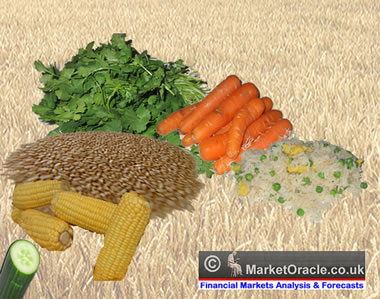How To Profit From Soaring Food Prices With ETFs
Commodities / Exchange Traded Funds Jun 05, 2009 - 04:34 AM GMT Ron Rowland writes: Global food prices are climbing higher along with energy and precious metals. In May, the Reuters/Jefferies CRB Index, which tracks 19 raw materials including corn, crude oil, and gold, surged by 14 percent — its biggest monthly gain since 1974!
Ron Rowland writes: Global food prices are climbing higher along with energy and precious metals. In May, the Reuters/Jefferies CRB Index, which tracks 19 raw materials including corn, crude oil, and gold, surged by 14 percent — its biggest monthly gain since 1974!
What’s behind this move? Simple: The U.S. government’s massive spending is killing the dollar and setting off inflation. At the same time, China’s massive economy is still growing like crazy. And the insatiable Chinese demand for all kinds of resources looks set to continue despite the global recession.
 |
| Grain prices are soaring! |
In last week’s Money and Markets column, I explained how you can trade gold with ETFs. Today we’re going to look at the ways you can play the uptrend in agricultural products — without using futures or options.
Method #1: Buy Individual Agricultural Companies
One way to invest in rising food prices is to buy the stocks of companies in the “agribusiness” sector.
You’ve probably heard of companies like Archer Daniels Midland (ADM), John Deere (DE), Monsanto (MON), and Tyson Foods (TSN).
Of course, individual stock picking takes a lot of time and research. What if you just want to get broad exposure to the whole group?
Then you can use …
Method #2: Buy Agribusiness Stock-Based ETFs!
 |
| Archer Daniels Midland is a top player in the food business. |
For instance, take a look at Market Vectors Agribusiness ETF. The ticker symbol is MOO, and it has all the companies listed above plus a few dozen more — including many non-U.S. stocks that are hard to access otherwise.
PowerShares Global Agriculture (PAGG) is another ETF covering this space. Either MOO or PAGG will give you a good cross-section of agriculture-oriented stocks from around the world.
Of course, stock based ETFs — while great — only provide “indirect” exposure to the underlying grains and agricultural products. What if you want direct access to the commodities themselves?
Method #3: Use Commodity-Focused ETFs and ETNs
You can now buy your way into the grain markets just as easily as you buy a stock — without the stress of leveraged futures and options.
For instance, PowerShares DB Agriculture Fund (DBA) tracks an index of four key markets: Corn, wheat, soybeans and sugar. With these in your pocket, you’ll be ready to profit as inflation sends worldwide food prices through the roof.
The iPath Dow Jones-AIG Agriculture Total Return Sub-Index ETN (JJA) is similar to DBA but is a little more diversified, adding coffee, cotton and soybean oil to the mix.
The last broad-based, commodities ETF I want to discuss today is Elements Linked To Rogers International Commodity Index — Agriculture Total Return (RJA).
RJA follows an index of 20 agricultural commodities developed by legendary investor Jim Rogers. It includes all the major markets plus several smaller ones: Canola, orange juice, oats, rubber, live cattle, lumber, cocoa, and more.
What about Single-Market Agriculture Funds?
If you want to zero in on one or more individual commodity markets, such as coffee or sugar, there are now easy ways to do that, too.
 |
| The iPath DJ AIG Coffee ETN lets investors buy directly into coffee. |
Several firms offer ETF-like products that do this for you. If it’s coffee you want, iPath has an ETN that tracks java prices. The ticker is JO. There are others for livestock, cocoa, and sugar.
However, I suggest that most people stay away from individual commodities, for two reasons:
First, the risk is very high. Unless you’re very confident in what you’re doing, or you’re getting the guidance of a bona fide commodities expert, you’re probably better off leaving these laser-focused investments out of your portfolio.
Second, these funds are fairly new and tend to have low trading volumes, which implies they are not very liquid. That means you may get hurt by higher transaction costs.
In other words, it’s far better to follow the major trends with one of the more diversified, agriculture securities I’ve mentioned earlier.
Another thing to keep in mind is that many of the commodity-tracking vehicles are ETNs, not ETFs. That means you are exposed to the issuer’s credit default risk. (See my February 6, 2009, Money and Markets column to learn why ETNs may be riskier than they look.)
I’m not trying to scare you away from ETNs, of course. Far from it — I use them myself. I just want you to be aware of what you’re getting into.
Bottom line: If we’re entering a major inflationary trend, food prices could go much, much higher. And the exchange-traded products that hold commodities and/or agricultural companies could shoot up as well.
Best wishes,
Ron
This investment news is brought to you by Money and Markets . Money and Markets is a free daily investment newsletter from Martin D. Weiss and Weiss Research analysts offering the latest investing news and financial insights for the stock market, including tips and advice on investing in gold, energy and oil. Dr. Weiss is a leader in the fields of investing, interest rates, financial safety and economic forecasting. To view archives or subscribe, visit http://www.moneyandmarkets.com .
Money and Markets Archive |
© 2005-2022 http://www.MarketOracle.co.uk - The Market Oracle is a FREE Daily Financial Markets Analysis & Forecasting online publication.



